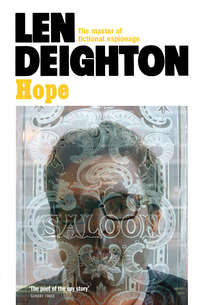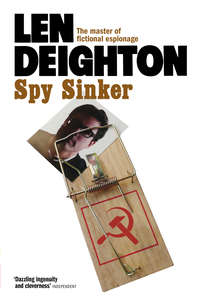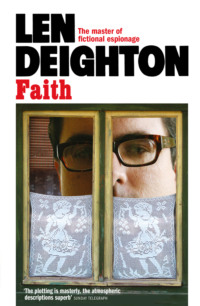
Полная версия
Fighter: The True Story of the Battle of Britain

Fighter
The True Story of the Battle of Britain
LEN DEIGHTON

CONTENTS
Title Page
Cover Designer’s Note
Illustrations
Preface to the 2014 Edition
Introduction by A. J. P. Taylor
PART ONE Strategy
PART TWO Air Chief Marshal Sir Hugh Dowding, Commander in Chief Fighter Command
PART THREE Weapons: The Metal Monoplane and Radar
PART FOUR Tactics
PART FIVE The Results
Acknowledgements
Selected Bibliography
Index
About the Author
Also By Len Deighton
Copyright
About the Publisher
Cover Designer’s Note
The story of the Second World War is one of tremendous technological change combined with great human emotion. When I set out to design the covers for this reissue of Len Deighton’s trilogy of Second World War histories, Fighter, Blitzkrieg and Blood, Tears and Folly, I wanted to incorporate both of these elements into a unified design theme that could be used on all three books. The books were among the first to offer a balanced narrative of the war with both sides of the story being represented, and I felt it was essential that the cover designs were similarly complete.
To convey the concept of technological change and development I created illustrations that begin as a set of plans on the back cover and continue across the spine to become a full-colour image of a fighting machine on the front. Many things we take for granted today, such as the mobile phone, microwave and air-traffic control, owe their development to the innovation that took place during the war.
The Second World War affected the lives of every man, woman and child living in Western Europe between 1939 and 1945. Television news has made us accustomed to watching remotely piloted drones waging war from the safety of our living room sofas, uninvolved except for the opinions we choose to express. In contrast I felt it was important to remind readers of the direct participation and sacrifice made by everyone during the war, so I carefully chose photographs of women in a variety of roles.
One such woman was my grandmother, an audacious and inspirational person who left her job as a chef to become a skilled oxyacetylene welder making flame traps for night-fighters. Thousands of women like her, building airplanes, tanks and ships, were immortalized in America by the ‘Rosie the Riveter’ campaign. Britain’s survival during the leanest days of the war owes a debt of gratitude to the Women’s Land Army. These hard-working women succeeded in cultivating every available square foot of land and saved the country from starvation when the U-boat campaign was at its most successful.
The extraordinary women of the First Aid Nursing Yeomanry created a secret unit that was dropped by parachute behind enemy lines to undertake espionage work for the Special Operations Executive. Bletchley Park’s work in cracking the ‘Enigma’ codes is well known, and many of the brilliant code-breakers were women. The magnificent women ferry-pilots of the Air Transport Auxiliary flew everything from fast and nimble Spitfire fighters to large and powerful Lancaster heavy bombers, many with battle damage and in need of repair. The Royal Air Force and Royal Navy depended on an army of women radar controllers to manage their operations in the air and at sea.
The contribution to the war made by women was not limited to Britain. In America Jacqueline Cochrane’s famous Women’s Airforce Service Pilots ferried military aircraft, while flight nurses – the unsung heroines of the US Army – provided critical medical attention to wounded soldiers, saving lives on both the European and Pacific fighting fronts. In Russia, too, all the Red Army’s nurses were women. Those serving as front-line medics were also armed and expected to fight alongside their male comrades when not attending to the wounded. Their casualty rate was approximately equal to that of the Red Army infantry. These women demonstrated that they were every bit as willing to help win a war against an enemy that threatened the life they knew. Together they blazed a trail for equality and their lasting contribution to today’s society deserves to be recognized.
Fighter: The True Story of the Battle of Britain tells the story of Germany’s attempt to gain control of the air above Britain in preparation for invasion. Technological advances in aircraft design, radar and planning played an important role in the Battle’s final outcome. Although the Hawker Hurricane bore the brunt of the fighting, Mitchell’s superb Spitfire was the more technically advanced aircraft with its all-metal construction and monocoque fuselage. The rapid pace of aircraft development at that time is represented by a Spitfire Mark IIA, serial number P7350. Beginning as a set of line-drawn plans on the back cover, it becomes a full-colour illustration on the front cover; its brown and green upper surfaces and pale underside having become an emblematic symbol of the Battle. Wearing the squadron codes UO-T, Spitfire P7350 was assigned to 603 Squadron based at RAF Hornchurch in October 1940. A genuine Battle of Britain participant, she survived the war and still flies today as part of the Battle of Britain Memorial Flight. The front-cover photograph is a period-correct image that immediately tells the story of the Battle through the eyes of the civilian population. The two schoolgirls sitting on the wing of a crashed Heinkel He 111 clearly convey the threat of German bombing with the everyday stoicism of the children who were innocent participants.
Antoni Deighton, 2013

Taedet caeli convexa tueri
(It becomes dispiriting constantly to watch the arch of heaven)
VIRGIL, AENEID, Book IV
Preface to the 2014 Edition
I remember the daylight raids in the summer of 1940. Sometimes whole formations of German bombers slipped between the radar beams and evaded the RAF fighter squadrons. One such daytime air raid remains a vivid memory. There must have been fifty bombers and they were flying in a box formation. I was in Marylebone Road (my father was in charge of an air-raid medical post situated temporarily in the Western Ophthalmic Hospital). Everyone was looking up at the planes and much of the motor traffic had stopped. No one ran for cover but that may have been due to the shock of seeing the enemy so near, so resolute, so seemingly fearless. Their formation so perfect, like the ones my father had taken me to see at the Hendon air displays before the war.
Steadily the formation passed over to bomb north London. The motor traffic around me started up again, and life continued as if on a normal peacetime day. That’s how the war was during those early days after Hitler’s armies had smashed their way through Allied defences to occupy Belgium, France and Holland. Our morale was high. Winston Churchill was in Downing Street and there was a consensus that it was better to be without Continental obligations.
The daylight air battles of 1940 ended when September arrived. As the days shortened the German bomber fleets attacked at night. At daybreak each morning we emerged from the air-raid shelter and walked home past shattered buildings. On one such dreadful morning in Crawford Street, Marylebone, Mr Stabler’s newsagents corner shop from which I did my paper-round was just a tall pile of broken bricks. Mr Stabler was under them and dead. There would be no paper-round that morning or for any mornings to come. My parents hurried me along lest I was late for school. The night bombers came again and again; they came every night for three months. And for civilians in England the war had only just begun.
The Battle of Britain was undeniably a turning point in world history. I say ‘undeniably’, but there are quite a number of people who continue to debate that fact. Simplistic reasoning encourages such people to say that in the summer of 1940 the German Navy was in no shape to support an invasion, and that in any case the Germans had none of the specialist landing craft and weaponry that proved vital for the Anglo-American armies landing in Normandy four years later.
All that is true; but if the Germans had defeated Fighter Command the German Luftwaffe would have ranged over England with impunity. With command of the air the Germans could have come across the English Channel without hindrance. Britain’s army, shattered after the Dunkirk evacuation, bereft of its heavy equipment and still re-forming its regiments, would have been no match for the battle-hardened German armies that were now brimming with the self-confidence of victory after victory and raring to complete their conquest of Europe. As the old saying goes: ‘Without Trafalgar there would have been no Waterloo.’ The Battle of Britain was Trafalgar.
Writing this book was a project very dear to my heart. There was a time when I believed that history is self-rectifying. I believed that, no matter how distorted the accounts of news and current events, in the course of time a more truthful and useful consensus would emerge. Now I know better. In fact it is the myths and fabrications that endure and become each nation’s historical reference. With this in mind I was determined to write an account of the Battle that was as accurate as I could make it.
I had served in the RAF and, as a photographer, flown in Lancaster bombers and Mosquito fighters. Many of my friends were RAF men. I had written Bomber, a fictional but realistic account of an RAF air raid on Germany. During the research for Bomber the Royal Netherlands Air Force had most kindly let me spend time on their airfield at Deelen, which was little changed from when the Luftwaffe was there. By the kindness of good friends I was able to be one of the crew of a Heinkel He 111 that was flown to Germany. The gleaming black bomber was due to go into a museum and, for that reason, special permission had been granted for it to keep its Luftwaffe livery, even including the strenglich verboten swastika on the tail fin.
There were few pilots qualified and checked-out to fly an ancient Heinkel bomber from England to Germany. Our pilot let no one think that this task gave him any pleasure. Along with me the third member of the crew was a cheerful American. After a brief hello we climbed aboard to start our flight to Siegen, a tiny hill-top airfield about 50 miles east of Cologne. We were airborne, heading east at about 4,000 feet (no pressurized cabin so this was high enough), when the pilot asked if anyone had brought a map. Luckily I had a couple of maps that were given free to customers at Esso petrol stations. Dedicated to the needs of motorists, they were updated frequently. This was a time when in Belgium the autoroutes were still being built, starting with the clover-leaf interchanges. It was their bright concrete patterns that made it reasonably easy to see where we were. To do this comfortably I spread myself out in the bomb-aimer’s position. It was soon after settling in there that I heard the pilot call to the American and say that we were running out of fuel and would have to land somewhere soon. From my map reading I could see we were now nearing Antwerp, and any remaining doubts were removed as we approached the airport and saw ANTWERP painted in giant letters across the roof of a hanger.
I have no idea what flight plan had been prepared, but subsequent events showed clearly that the Belgians in the air-traffic control tower at Antwerp were unprepared for a Luftwaffe bomber, complete with sinister black crosses and a large swastika, circling the airfield and descending lower with each circuit. We landed without permission. They were, we gathered, angry. But the men on the petrol bowser were keen to do business and as soon as they understood our need for fuel they were climbing over the wings with nozzle in hand. It wasn’t as easy as it looked. Whatever kind of cap device the Luftwaffe had on their petrol tanks it did not reconcile readily with Belgian nozzles. But eventually the petrol flowed and one of the tanks was filled. I won’t describe the scene that followed as the Belgian bowser men demanded cash payment. Our pilot shrugged, the American said he had no money, and when it seemed that we were all going to be interned or imprisoned or merely beat about the head, I offered them my American Express card. In the absence of any alternative, and the petrol already aboard, they took it. It was only after we were back in the air that the American discovered that we had never been short of petrol. There was a switch above the pilot’s head which, when one tank was empty, transferred fuel to the other tank.
This unscheduled landing had delayed our arrival at Siegen by over two hours but I was amazed to see at least a thousand spectators still waiting there in the drizzling rain to greet us. As we stepped from the bomber one-time ‘General of Fighters’ Adolf Galland, the most famous of all German ace pilots, together with a group of veteran flyers, greeted us with gratitude; as if we were personally donating the Heinkel to them.
While we warmed up over coffee with the flyers in a tiny airport restaurant Galland said to me, ‘Is there anything we can do for you?’
It was a once-in-a-lifetime offer. I said, ‘I am trying to find a night-fighter veteran who flew Junkers Ju 88s against the RAF night bombers.’
‘Easy,’ said Galland and within thirty minutes I was in a light plane heading to Düsseldorf and an evening talking with ‘Fips’ Radusch, a famous Luftwaffe night-fighter ace.
I was lucky over the years to meet and correspond with combatants of all ranks on both sides of the war. As I talked to these men – aided immensely by my wife Ysabele’s linguistic skills, which enabled me to pass through doors that would otherwise have remained shut – it became clear even then that the egos of the victors had started to obscure historical fact. It was time to untwist the record. I was determined to write a history book unlike all the history books I had read – and I had read many – a book that dealt more in facts than in opinions.
So you will see I have given prime importance to the men and their machines. For example, it was Britain’s remarkable good fortune that Rolls-Royce had produced the Merlin engine. Fitted into Supermarine’s Spitfire airframe it became a weapon that was in every way the equal of the Messerschmitt Bf 109 that opposed it. The performance of the two aircraft was remarkably similar; range, horsepower, speed, ceiling and manœuverability. But while the Daimler Benz engine in the Messerschmitt was of 33.93-litres the superb Merlin had a capacity of only 26 litres. There were many elements at play in the Battle, but the Rolls-Royce Merlin engine was an incomparable masterpiece of engineering and a war-winner. Fitted into the Hawker Hurricane – a more primitive airframe but far more numerous in the Battle – it made a formidable fighter. Squadron fitters and riggers could often mend shot-up Hurricane airframes without sending them to the few overworked specialists who repaired the Spitfires. But there were other factors that can’t be ignored. In the crucial month of June 1940, while the British factories produced 446 fighters, the Messerschmitt factory at Augsburg produced 140.
It was while comparing this Daimler-Benz engine with the Rolls-Royce Merlin that I became interested in aero-engines and saw for the first time their prime importance in the entire history of aviation. From the Wright brothers right up to the present day, airframe designers have to wait upon engine manufacturers before completing their work on the drawing boards. I found it compelling from many points of view. The personal vendettas, stupidity, treachery and corruption in the contracts, the determination of governments and businessmen to distort progress made for a fascinating social history as well as a military one. It was a neglected aspect of aviation and I embarked upon a history of aero-engines; perhaps one day I will publish it.
Meanwhile, here is the story of the Battle of Britain – our Trafalgar – and I have told it with an overriding determination to stick to the truth. If it shatters some myths and flag-waving nonsense it is only to reveal a more inspiring truth of which we can be proud and grateful.
Len Deighton, 2013
Introduction
by A. J. P. Taylor
Bismarck once asked Count Helmuth von Moltke whether he could guarantee victory in the coming war against Austria. Moltke replied, ‘Nothing is certain in war.’ War is indeed full of surprises and the Second World War had many, from the German breakthrough at Sedan in May 1940 to the dropping of the two American bombs on Japanese towns in August 1945. No action, however, was as surprising and unexpected as the aerial combats between the Royal Air Force and the Luftwaffe in the summer of 1940. Imaginative novelists, and particularly H. G. Wells, had described future engagements between vast armadas of the air. Few of those who determined air strategy in practice believed that such forecasts had any reality.
The key to the story is that the air commanders before the Second World War had very little previous experience to draw on. The materials and methods of war are of course constantly changing. Generals acquire rifles, machine guns and tanks. Admirals acquire bigger battleships and submarines. But they have some idea from earlier wars of the problems that are likely to face them. The air commanders had no such resource. The war in the air of the First World War had been largely a matter of dog-fights between individual aircraft. The few bombing raids had caused terror and little effective damage. Those who determined air strategy after the war had to proceed by dogma alone, a dogma that was little more than guesswork.
The dogma was simple: ‘The bomber will always get through.’ General Giulio Douhet said this in Italy; Billy Mitchell said it in the United States. Both were detached theorists. It was more important that Lord Trenchard said it in England, for Trenchard was Chief of Air Staff for ten years, from 1919 to 1929. Trenchard was determined to have an independent air force, and the only way for it to be more than an auxiliary of the army and navy was to have a strategy of its own. This strategy was independent bombing. The air commanders practised this strategy successfully. The British bombed defenceless villages in Iraq; the Italians bombed defenceless villages in Abyssinia; the Germans bombed defenceless villages in Spain; the Japanese bombed defenceless cities in China.
But was there no defence? The air chiefs answered unanimously: none. The only answer was to possess an even stronger bomber force than the enemy with which to destroy his bases and his industrial resources. The British, thanks to Trenchard, accepted this doctrine wholeheartedly. They calculated the strength of the largest air force in Europe and made this their yardstick, just as British Admirals had made the German navy their yardstick before the First World War. In the early days the French air force provided the yardstick, though it is difficult to believe that there was ever a serious chance of a war between France and Great Britain. In the 1930s the German Luftwaffe became the obvious rival. The British Air Staff clamoured for more bombers and, when the RAF slipped behind, declared that Great Britain was in imminent danger. Everything, it seemed, turned on the bomber race.
In December 1937 there was a revolution in British air policy. It was sensational though little regarded. The year before, Sir Thomas Inskip had been made Minister for the Co-ordination of Defence. He was an unimpressive figure whose appointment had been dismissed as the most surprising since Caligula made his horse a consul. But Inskip had a clear lawyer’s mind. He recognised that the British were losing the bomber race with Germany. Then he proceeded to the striking conclusion that it was not necessary for them to win it. For while the Germans aimed at a short war and therefore wanted a knock-out blow, the British merely needed to survive until blockade and perhaps the aid of allies brought victory in a long war. In his own words, ‘The role of our Air Force is not an early knock-out blow … but to prevent the Germans from knocking us out.’
Inskip had also a practical argument. Previously it had been plausible and perhaps even reasonable to claim that there was no defence against bombers and that they would always get through. Now there were new assets on the British side. Their new fighters, especially the Spitfire, were faster and more formidable than any that had gone before and could challenge the German bombers. Radar was being developed by British scientists and with it the British fighters would know when the bombers were coming. Defence was possible after all. Of course this, too, was a dogma, not based on experience. In Inskip’s view it was worth trying.
He had a still more practical argument. Fighters cost less than bombers to build. Therefore more could be produced for the same money and the great British public, who understood nothing of the difference between fighters and bombers, would be the more impressed. This argument was decisive with the Cabinet, which accepted Inskip’s recommendation on 22 December 1937. The Air Marshals raged and Trenchard declared in the House of Lords that the decision ‘might well lose us the war’. But the revolution in British air policy had begun. Some of Inskip’s arguments, such as his reliance on blockade, were mistaken. But he deserves some credit as the man who made British victory in the Battle of Britain possible.
The second man who exercised decisive influence also arrived at his position in an almost accidental way. Sir Hugh Dowding was the senior member of the Air Council. He had every claim to become Chief of Air Staff in 1937. But he was a quiet, reserved man, obstinate in pressing his views and not a good mixer. He was pushed off to become head of Fighter Command, then regarded by the other Air Marshals as a second-rate post. Dowding considered the problem of fighter strategy in his cool, rational way. Far from him was any romantic idea of vast armadas contending in the skies or of dog-fights such as there had been in the First World War. The sole task of Fighter Command, as Dowding saw it, was the defence of Great Britain and this could be accomplished by defeating the German bombers. Without them the German fighters would be harmless. Dowding planned an economical campaign to husband his fighter force at all costs.
Dowding’s single-minded concentration on the defence of Great Britain often brought trouble for him after the war started. When the Germans broke through in Flanders the French pleaded for more British fighter squadrons. Churchill acquiesced. Dowding resisted this emotional decision and got his way after the Chief of Air Staff appealed to the Cabinet on his behalf. In July, when the Germans began to attack British shipping in the Channel, Dowding again refused to involve his fighters in this to him irrelevant conflict. Dowding also had trouble within his own force. Some of the area commanders resented Dowding’s cautious policy and clamoured for the tactic of the ‘big wing’. All along Dowding suffered from disloyalty as well as from lack of understanding.
There was a third decisive figure in the Battle of Britain. In May 1940 Churchill made Lord Beaverbrook Minister of Aircraft Production. Beaverbrook’s task was to produce aircraft as quickly as possible without regard to established procedure. He discharged this task successfully and to the great annoyance of the Air Marshals. Beaverbrook was an isolationist who had little interest in the continental war. He came alive only when the defence of Great Britain was in question. He formed a close alliance with Dowding, who shared his outlook. Beaverbrook turned out fighters where the Air Marshals called for bombers. He sent new fighters direct to the squadrons. He trampled over all bureaucratic obstacles. Dowding paid him this tribute: ‘The country owes as much to Lord Beaverbrook for the Battle of Britain as it does to me. Without his drive behind me I could not have carried on during the battle.’ Thanks to Beaverbrook, Fighter Command possessed more aircraft at the end of the Battle than it had possessed at the beginning. But as Len Deighton shows, not even Beaverbrook could remedy the wastage of pilots.









